
Home »
|
|
|
||
|
Home » |
|||
Side Position (Recovery Position)
|
|||||||||||||||||||||||||||||||||||||||||||||||||||||||||||||||||||||||||||||||||||||||||||||||||||||||||||||||||||||||||||||||||||||||||||||||||||||||||||||||||||||||||||||||||||||
|
Four steps to save a life |
||
| Check for responsivness | ||
|
| V |
||
| Person does not react normal | ||
|
| V |
||
|
|
||
|
| V |
->
no breathing: start
|
|
| You can hear, feel and see breathing | ||
|
| V |
||
|
Step 1 |
||
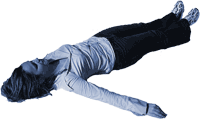 |
||
|
Stretch out one arm straight and right-angled. |
||
|
Step 2 |
||
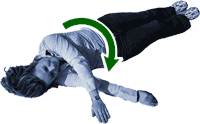 |
||
|
Grab victims shoulder and hip. Pull or push the person on the side of the arm stretched out. |
||
|
Step 3 |
||
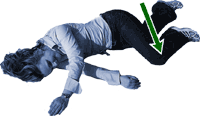 |
||
|
Bend one leg, pull the knee towards chin as far as possible. |
||
|
Step 4 |
||
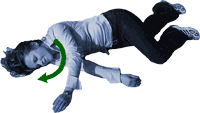 |
||
|
Tilt the persons head back. Do not put any object unter victims chin or head - neither the hand of victim! Corner of mouth must be the lowest point of the head. |
||
|
Call your local
|
||
|
Check victims reactions (responsivness) and breathing activity continually. |
||
The side position shown above is one possible technique. It is not necessary to follow exactly the instructions but keep in your head that best protection against choking is the low corner of mouth.
First assess the scene: Check for danger to the victim and yourself (traffic, electricity, smoke)
|
Check for responsivness:
|
||
|
| V |
||
|
Eye response |
||
|
Open spontaneously, at the latest to verbal commands |
Open to pain or no response |
|
|
Verbal response |
||
|
Talking and fully orientated |
Confused or disorientated, inappropriate words, incomprehensible sounds or no response |
|
|
Motor response |
||
|
Spontaneous purposeful moving, obeys commands |
Moving without taking aim, especially to caused pain, localizing pain or no response at all |
|
|
Reactions totally normal "Conscious" |
Reactions not normal "Unconscious" |
|
|
| V |
| V |
|
|
Give the person the necessary aid. Call your local emergency number if any doubt about a danger exists. |
Position the person on the side. Immediately call your local emergency number. Return to the victim and check breathing. |
|
Note:
Responses and reactions of humans may vary in great extent. It is difficult to determine exact signs for "consciousness" and "unconsciousness". If a person does not respond totally normal, call the emergency number at once. If you are wrong about the situation and the person is not in danger when the ambulance arrives, no one will be angry about, except for malicious calls.
Disturbed consciousness can accompany stroke or alcoholic poisoning and many other internal or neurological diseases. Unconsciousness is ever a major sign of danger to life.
» Causes of unconsciousness: coming soon
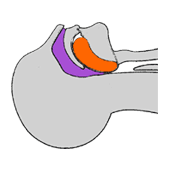 |
« Figure 1 Because all muscles relax by loss of consciousness, also the tongue does. In supine position the tongue can slide into the throat and can block the airway (additionally fluids may come into the lungs). |
To check breathing, position the person on her or his back, tip the victim's head back and lift the chin (Fig. 2).
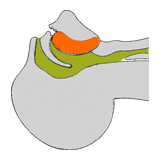 |
« Figure 2 Extend the neck to open the airways: Look, listen, and feel for breathing. Watch the chest to see if it rises. |
If you can not see, listen, and
feel breathing, or if you are not sure that the person is breathing, start
![]() CPR. According to the
new guidelines for resuscitation you abstain from searching for pulse. The
decisive factor to begin with 30 chest compressions is the absence of
breathing activity.
CPR. According to the
new guidelines for resuscitation you abstain from searching for pulse. The
decisive factor to begin with 30 chest compressions is the absence of
breathing activity.
A conscious person who is choking has the airway blocked by a piece of food or foreign body. A choking conscious person should cough forcefully while you can tap on the victim's back (between shoulder blades).
If the person is unconscious you can solely suspect a foreign body in the airways. If the person is in supine position, the victim's tongue is the foreign body! You do not need to grasp into the mouth - you can remove the tongue easily by extending the neck and lifting the chin.
Despite a blocked airway and the victim's impossibility to breathe, you will be able (in most cases) to give breaths. A first aider has more power than a victim, so artificial respiration will work.
Technical Information
Heimlich Manoeuvre can cause serious injuries of stomach organs, for example. We can not give definitive advice at the moment therefore we go without an instruction of Heimlich's Manoeuvre. Possibly the Heimlich Manoeuvre is a dangerous measure which can be replaced by harmless techniques. There are many scientific articles reporting fatal outcomes whereas detection of benefit is quite difficult.
We will report.
» A review of relevant articles is cooming soon
Side Position on Suspected Spine Injury
The spine is a flexible column of bones with the spinal cord in there. The spinal cord consists of many nerve fibres coming from the brain to the organs. We want to avoid any damage of these nerves. In case of unconsciousness the protection of airway is the most important aspect.
If a person is unconscious and breathing and a spine injury is suspected:
Bring the victim to the side position. Be careful - as always!
Please note:
An unconscious person is in great danger if she or he lies on her/his back. The only way to protect her/him from choking is the side position.
» Further information coming soon
A festival for firstaiders: The Oktoberfest
Soon we will tell you some first-aid stories from the Oktoberfest (Munich, Germany). The excessive consumption of beer leads to huge amount of emergencies. See this funfair with the eyes of a first aider.
» Coming soon
|
CONTENT OF THIS PAGE |
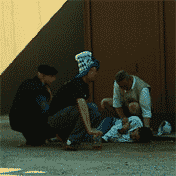 |
|
1995-2007 The Gohelp Society · V. 6.0.11 (Site
last updated Sep 22, 2007) |